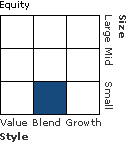| CVT S&P MidCap 400 Index F |
|
 |
|
| Release date as of 2025-09-30. Data on page is subject to change. |
|
|
Overall Morningstar
Rating™
|
| What is this?
|
|
 |
| As of 2025-09-30 |
|
Out of 373
Mid-Cap Blend Funds
|
|
|
|
|
|
| Total Fund Assets ($ Mil) |
| 611.56 |
|
|
|
| Investment Objective & Strategy |
|
| The investment seeks investment results that correspond to the total return performance of U.S. common stocks, as represented by the S&P MidCap 400 Index.
|
|
| Under normal circumstances, the fund will invest at least 80% of its net assets in investments with economic characteristics similar to midcap stocks as represented in the index. The index is an unmanaged index comprising common stocks of 400 mid-sized U.S. companies. |
|
|
| Morningstar Category: Mid-Cap Blend |
|
| The typical mid-cap blend portfolio invests in U.S. stocks of various sizes and styles, giving it a middle-of the-road profile. Most shy away from high-priced growth stocks but aren't so price-conscious that they land in value territory. Stocks in the middle 20% of the capitalization of the U.S. equity market are defined as mid-cap. The blend style is assigned to portfolios where neither growth nor value characteristics predominate.
|
|
|
| Mid Cap Funds: The securities of companies with market capitalizations below $10 billion may be more volatile and less liquid than the securities of larger companies. |
|
|
| % of Net Assets |
 |
U.S. Stocks |
96.4 |
 |
Non-U.S. Stocks |
2.3 |
 |
Bonds |
0.3 |
 |
Cash |
0.9 |
 |
Other |
0.0 |
|
|
 |
| Data through 2025-08-31 |
|
|
|
|
| Morningstar Equity Sectors |
|
|
|
% of Stocks |
 |
Cyclical |
40.90 |
 |
Basic Materials |
3.97 |
 |
Consumer Cyclical |
13.19 |
 |
Financial Services |
16.26 |
 |
Real Estate |
7.48 |
|
|
|
 |
Sensitive |
42.49 |
 |
Communication Services |
1.29 |
 |
Energy |
3.76 |
 |
Industrials |
22.62 |
 |
Technology |
14.82 |
|
|
|
 |
Defensive |
16.61 |
 |
Consumer Defensive |
4.72 |
 |
Healthcare |
8.76 |
 |
Utilities |
3.13 |
|
| Data through 2025-08-31 |
|
|
| Total Number of Stock Holdings |
401 |
| Total Number of Bond Holdings |
1 |
| % of Net Assets in Top 10 Holdings |
7.97 |
|
|
| Turnover % |
(as of 2024-12-31) |
16.00 |
| 30 Day SEC Yield % |
0.00 |
|
|
Sector |
P/E |
% of Net
Assets
|
 |
 |
 |
 |
 |
 |
SPDR® S&P MIDCAP 400 ETF Trust |
--- |
--- |
1.55 |
 |
Morgan Stanley Inst Lqudty Gov Sec Ins |
--- |
--- |
0.94 |
|
EMCOR Group Inc |
 |
31.36 |
0.88 |
|
Comfort Systems USA Inc |
 |
41.38 |
0.78 |
|
Pure Storage Inc Class A |
 |
232.85 |
0.76 |
 |
|
RB Global Inc |
 |
--- |
0.67 |
|
Flex Ltd |
 |
--- |
0.65 |
|
Casey's General Stores Inc |
 |
34.40 |
0.58 |
|
Burlington Stores Inc |
 |
31.97 |
0.58 |
|
Guidewire Software Inc |
 |
312.41 |
0.58 |
 |
|
 |
|
|
|
|
|
| Lending, Long-Term Outlook and Projections, Loss of Money, Not FDIC Insured, Index Correlation/Tracking Error, Market/Market Volatility, Equity Securities, ETF, Industry and Sector Investing, Restricted/Illiquid Securities, Derivatives, Shareholder Activity, Passive Management, Portfolio Diversification, Small Cap, Mid-Cap, Real Estate/REIT Sector |
|
| Show Risk Definitions |
|
|
| Inception Date: 2007-10-01 |
|
| Kevin L. Keene (2008-11-30) |
|
| Kevin L. Keene,
CFA May 2014 -present: Portfolio Manager, Ameritas Investment Partners, Inc.
April 2013-April 2014: Assistant Portfolio Manager, Ameritas Investment Partners, Inc.
2011-2013: Senior Analyst, Ameritas Investment Partners, Inc.
2008-2011: Equity Index and Derivatives Analyst, Ameritas Investment Partners, Inc. |
|
|
|
| Calvert Research and Management |
|
|
| Calvert Research and Management |
|
|
| Ameritas Investment Partners, Inc |
|
|

© Copyright 2025 Morningstar, Inc. All rights reserved. Morningstar, the Morningstar logo, Morningstar.com, Morningstar Tools are either trademark or service marks of Morningstar, Inc. The information contained herein: (1) is proprietary to Morningstar and/or its content providers; (2) may not be copied or distributed; and (3) is not warranted to be accurate, complete or timely. Neither Morningstar nor its content providers are responsible for any damages or any losses arising from any use of information. Past performance is no guarantee of future performance. |
|
Past performance is no guarantee of future results.
Returns will vary and shares may be worth more or less than their original cost when sold.
|
|





















